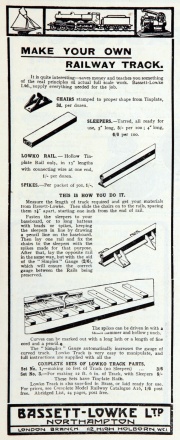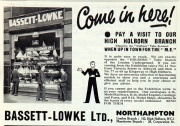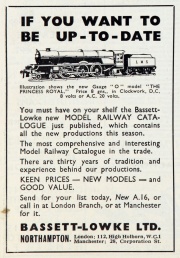Bassett-Lowke























































of 16-20 Saint Andrew's Street, Northampton. Telephone: Northampton 4122-3. Cables: "Bassett-Lowke, Northampton". London Office and Showrooms: 112 High Holborn, WC1.
Wenman Joseph Bassett-Lowke took up the hobby of making model stationary steam engines. Realising the impossibility for the ordinary enthusiast of purchasing small parts, which he had made in his father’s workshops, he soon began a small mail-order business. His father’s bookkeeper, H. F. R. Franklin, joined him in the project.
1899 Bassett-Lowke was a born salesman, and in 1899 he and his partner published their first catalogue. Realising the value of photographs, but unable to afford printed ones, they laboriously pasted real photographs into the catalogue. Later ones were fully illustrated and had striking covers designed by well-known draughtsmen.
1900 Bassett-Lowke was inspired by his visit to the Paris Exhibition, where he made contact with German manufacturers, from whom he bought model trains painted in British livery. Soon he began manufacture in Northampton.
1908 The company began making ‘waterline’ ship models. This type of model, showing only the parts above the waterline, were used in wartime as training aids for the Navy and Air Force. Yachts were also made to sail on boating lakes. Large shipping companies commissioned models of their luxury liners to display in their offices. Miniature railways were made for wealthy individuals and for exhibitions and resorts. The skilled model maker E. W. Twining formed Twining Models Ltd., which produced the highest quality architectural models with Bassett-Lowke Ltd.
1908-10 Bassett-Lowke opened his first London shop at 257 High Holborn, in 1908, moving to number 112 in 1910. His company made great use of trade shows, not only displaying their own goods, but often supplying companies with models, too. Many 15” gauge railways were installed to carry visitors around exhibitions. Usually, the displays were of smaller gauge models and large tabletop systems. However, mail order remained an important part of the business.
1910 The firm was incorporated as a limited company.
1912 See Bassett-Lowke: 1912 May Catalogue
1914 Listed as model engineers and ship model makers. Specialities: model locomotives from 1¼-inch gauge to 24 inches, model permanent way, model signals, stations and all accessories, model and small-power boilers and steam engines etc. Employees 180. [1]
1914 See Bassett-Lowke: 1914 November Catalogue
WWI. During the First World War of 1914-18, Bassett-Lowke made the gauges which tested the standard parts of guns.
WWII. During the Second World War of 1939-45, a great variety of work was done. A method of training for aircraft recognition, using mirrors, was devised. They produced training models of the sectional Inglis and later Bailey bridges. Perhaps the most important construction of this nature was the model of the floating Mulberry Harbour, which was used to land troops in Normandy in 1944.
1947 Listed Exhibitor - British Industries Fair. Manufacturers of Scale Models of Every Description. Railway, Ships, Aeroplanes, Engineering and Architectural Models. Drawings, Castings and Parts for Model Makers. High Class Toys. (Olympia, 2nd Floor, Stand No. J2294) [2]
1953 Wenman Joseph Bassett-Lowke died and afterwards the company continued to make high-quality ship and industrial models.
1967 The Bassett-Lowke and Franklin families sold their shares.
Models are no longer made in Northampton. The current owners of the marque are Corgi Classics of Leicester.
1974 Developed a modular system to enable model establishments to be made to assist in deisgn.[3]
Notes
- Bassett-Lowke has a dedicated website: [1]
See Also
Sources of Information
- ↑ 1914 Whitakers Red Book
- ↑ 1947 British Industries Fair p25
- ↑ The Engineer 1974/08/15
- [2] Corgi Website

